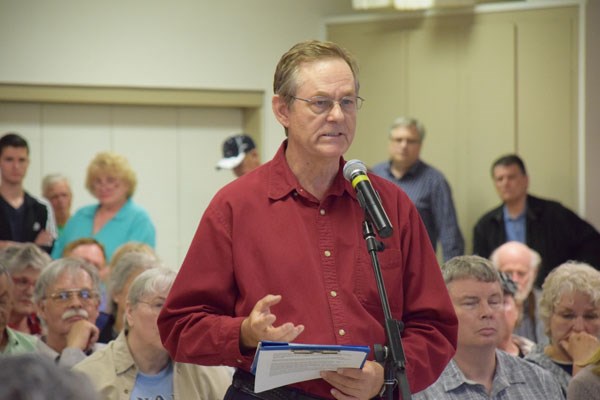Gibsons Mayor Wayne Rowe is seeking legal advice on whether he could be in a conflict of interest when it comes to a controversial development at 464 Eaglecrest Drive.
Rowe was absent from a packed public hearing on the project May 9, and deputy mayor Silas White read a brief statement explaining the situation.
“Yesterday [May 8] a resident inquired whether the proposed Stewart Road access to this proposed development puts Mayor Rowe in conflict of interest due to the location of his private residence,” White said. “Mayor Rowe has chosen to recuse himself this evening while he seeks a legal opinion on this question.”
The Eagleview Heights project, led by TCD Developments, calls for the land to be built out in three sections with a total of 87 units.
There would be four duplexes fronting Eaglecrest Drive, two rows of “eight duplex-form apartment pods” with five or six units in each one, and a block with a similar design but fewer units.
To move forward the developers need the property rezoned from Single Family Residential Zone 1 to Cluster Residential Zone 2.
The majority of the speakers at the hearing, which drew nearly 200 people, opposed the development, but according to Town staff the written submissions showed the opposite trend, with 85 in favour of granting the rezoning and 64 against.
Most of the objections were tied to the project’s density, which several speakers claimed would violate the official community plan (OCP), although Town staff say the development is conforming to the Low Density Residential 1 land use in the OCP.
William Baker of the O’Shea – Oceanmount Community Association, which was formed in part because of concerns about the Eagleview Heights proposal, said the association wants to see the project scaled back to “something we can live with.”
“This community is in favour of responsible development, even if it’s not affordable to working families – as is the case here. What we’re not in favour of is the significant density devastation that is being proposed for this neighbourhood.”
Baker also claimed the neighbourhood concerns were not taken into account during drafting of the plans. “Despite the fact, and our fervent desire to be consulted, we were sidelined while the developer and Town planning worked together.”
Later in the hearing, Stanley Yasin, one of the development’s proponents, defended the company’s efforts to listen to neighbourhood concerns and the resulting changes to the proposal.
“Last July we came to council with a proposal that we’d worked on for quite a number of months… It was very clear from council and the community that they were unhappy with the design and they all cheered when council suggested we go back to the drawing board and stay within the current official community plan,” he said. “We have, indeed, conformed to the current OCP. We have, from the original plan, reduced the height, the massing [and] the density and preserved the view corridors.”
Another member of the project team, Rob Chetner, also defended the consultation efforts, and used stronger language to characterize the opposition.
“There’s been a very unfair and biased campaign against this proposal, filled with inaccuracies and false assumptions since the project’s outset,” he said.
Common points raised in favour of the project included the $270,000 contribution to the Town’s affordable housing fund, the prospect of construction jobs and the additional housing supply that could ease pressure on the local stock from steadily increasing demand.
Other concerns raised by those who spoke against the rezoning included storm water management, traffic, emergency access, and the potential for setting a precedent.
One area resident, David Kipling, drew a round of applause, despite the chair’s request that the crowd refrain, when he said, “When you give the OK for 87 houses, instead of 45, there are developers across B.C. watching and listening and the minute you do that they say, ‘Right. We’re going in there.’ And next time it’s a hundred and fifty… They’re watching whether you roll over or not. Don’t roll over.”
The rezoning application will now go back to council for further readings.



